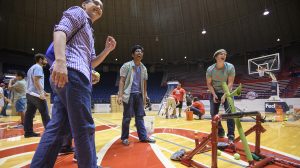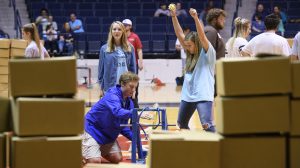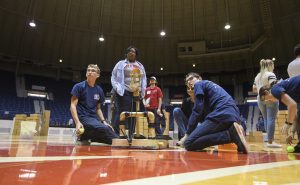
Members of the Hot-N-Spicy team from Desoto Central High School experience the joy of victory during the Siege the Castle event at UM’s annual Catapult Competition. Photo by Thomas Graning/Ole Miss Communications
OXFORD, Miss. – Normally, tennis balls volley back and forth on the tennis court, but Wednesday afternoon (April 12), the fluorescent yellow balls were being catapulted in the C.M. Tad Smith Coliseum at the University of Mississippi.
The School of Engineering, Center for Math and Science Education and Division of Outreach and Continuing Education hosted the 11th annual Catapult Competition. Middle and high school students from across Mississippi designed and constructed catapults and brought them to campus to test their engineering skills.
Catapults, which originated as ancient engines of war, hurl projectiles at targets. Among the most powerful medieval weapons, catapults known as trebuchets use a counterweight to propel their payload. Modern catapults use tension, such as a spring or elastic band, that is suddenly released to fling a projectile.
“This is the 11th annual Catapult Competition, formerly Trebuchet Competition,” said Tiffany Gray, research associate in the Department of Mechanical Engineering and co-coordinator of the event. “We changed the rules on what the students were building last year, so last year we changed the name to reflect this.”
In the UM competition, students designed and constructed catapults of metal, wood and PVC to hurl tennis balls across the field. Registering for the event were 17 teams representing eight schools: Central Hinds Academy, Desoto Central High School, Guntown Middle School, Lafayette Middle School, Oxford High School, Tishomingo County High School, Water Valley High School and West Jones High School.
UM engineering graduate students weighed and measured the catapults to make sure specifications were met. Catapults not meeting specs either had to be modified or were penalized points for not meeting the criteria.
Teams competed in Design, Pop-A-Shot, Humpty Dumpty and Siege the Castle categories. Catapults were scored on their design process, safety features, construction, creativity and originality, and team interviews.
First place overall went to America’s Mitochondria from Tishomingo County High School. Second and third places overall went to Sojourn, also from TCHS, and Memengineers from Oxford High School.

Students on the Enduring Frustration team from Tishomingo County High School are in the zone during the Siege the Castle event at the annual UM Catapult Competition.Photo by Thomas Graning/Ole Miss Communications
Winners in Pop-A-Shot were America’s Mitochondria (first), Indeed from Lafayette Middle (second) and Ultimus from Guntown Middle (third). In Humpty Dumpty, winners were America’s Mitochondria (first), Shorts from Central Hinds Academy (second) and Enduring Frustration from Tishomingo County (third). Siege the Castle winners were America’s Mitochondra (first), Hot-N-Spicy from Desoto Central (second) and Memengineers (third). In Design, Sojourn placed first, America’s Mitochondria took second and B.L.A.G.H. from Desoto Central came in third.
The Pop-A-Shot required teams to launch four shots from three different locations at a regulation basketball hoop. The Humpty Dumpty event called for teams to launch tennis balls in attempts to knock three cardboard boxes off a wall of blocks without disturbing the wall. The Siege the Castle competition required teams to use catapults to knock down a cardboard brick wall.
The Haley Barbour Center for Manufacturing Excellence created 3-D-printed desktop catapults for the overall winners. Plaques made in the Mechanical Engineering Machine Shop were presented for each category. The overall winner was the team with the highest total score.
Six Ole Miss graduate students judged the entries: mechanical engineering majors Damian Stoddard of St. Louis, Cody Berrey of Meridian and Zach Wallace of Batesville; civil engineering major Grace McMahen of Union; geology and geological engineering major Alex Weatherwax of Williamsburg, Virginia; and physics major Sunethra Dayavansha of Kandy, Sri Lanka.
The Sojourn team intentionally went for a more creative design for its catapult, said Samuel Zafic, a senior at Tishomingo County High School.
“Most everyone goes for the traditional arm and bar design,” he said. “Going a different route allowed me to experience some of what it’s like to be in the engineering profession.”
Davis Powell, a junior also from TCHS, described the annual Division of Outreach program as “amazing.”
“I entered the competition last year because it looked like it would be fun,” said Powell, who hinted he might return to the university as a biochemical engineering major after he graduates in 2018. “It is fun, but it is also challenging. I definitely plan on coming back for next year’s competition.”

Middle and high school students from across the state of Mississippi participate in the 11th annual Catapult Competition at Tad Smith Coliseum. Photo by Thomas Graning/Ole Miss Communications
Before the day’s final competitive event, participants faced off in preliminaries and made adjustments to their catapults. Sometimes, the machines broke during this process.
“It is impressive to see the tools come out and students making repairs to get their machine up and hurling again,” Gray said. “That is what the engineering experience is all about.”
The catapult project encourages students to think and use the engineering design process, engineering school staff members said.
“Each year, I see familiar faces from previous competitions,” said Matt Nelms of Oxford, a UM staff member who serves as the event’s co-coordinator. “It’s very meaningful to see these high school and middle school students mature and the extremely impressive engineering solutions they come up with at such young ages. Their intelligence always exceeds our expectations.”
In medieval times, trebuchets were more accurate than other catapults, which use tension or torsion to fire projectiles. In modern times, trebuchets have become popular devices for hurling pumpkins, frozen turkeys or even junk cars in light-spirited competitions.
For more information about the School of Engineering, visit http://engineering.olemiss.edu/.
For more about the Center for Math and Science Education, go to http://umcmse.com/. For more about the Division of Outreach, visit http://www.outreach.olemiss.edu/.